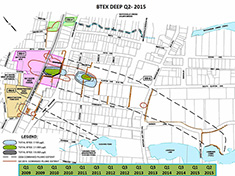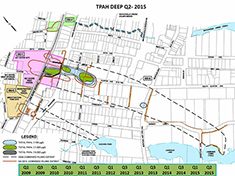Cleanup Progress
Substantial progress has been made since major construction began in 2007 to support the cleanup activities in Bay Shore, specifically in OU-1. Through October 2015, National Grid has completed or continued remediation activities at all four of the Operable Units which make up the site. The cleanup of this site is not yet complete, but contaminant levels have decreased sharply throughout the area, and with recent upgrades to the existing systems, this trend is expected to continue.
The site has been divided into four separate areas called Operable Units (OU-1 through OU-4). Each OU includes a specific portion of the project area.
Major cleanup activities in OUs 1, 2, 3 and 4 have been completed. In 2015, National Grid upgraded the 87 Community Road oxygen injection line and expanded the OU-1 South oxygen injection line across N. Clinton Avenue. The work is intended to target remaining downgradient localized groundwater impacts.
OU-3 is at the western end of the site. A large fuel storage tank and associated piping once stood in this area, containing a kerosene-like petroleum product that was used as the feedstock for the gas manufacturing process. Several other, smaller tanks were also present. OU-3 is defined to include the “Brightwaters Yard” portion of the original plant site west of North Clinton Ave., and the plume of contaminated groundwater which originated in this area and previously extended southward as a narrowband in the vicinity of Lanier Lane.
As was the case with OU-1 and OU-2, the cleanup strategy in OU-3 has been to remove as much of the contaminated source material as possible from the original MGP plant site, and to introduce oxygen into the groundwater to encourage soil bacteria to consume the contaminants that have already dissolved in groundwater and migrated beyond the site boundaries.
Contaminated soil in the Brightwaters yard was removed during several rounds of excavation. The most recent effort, in 2010, included temporary relocation of the LIRR tracks adjacent to the site to allow excavation of contaminated soil below the tracks.
A line of oxygen injection wells, similar to those in OU-2, was installed along the south side of Union Boulevard in 2000. This system was replaced in 2010 with a new system located on the north side of Community Road. An area of high groundwater contaminant concentrations was present in the area between the 2010 LIRR excavation and the new oxygen injection line. In response, National Grid upgraded the new Community Road injection system in 2012 and installed an additional oxygen injection system in August 2013 upgradient (north) of the Community Road system and south of the LIRR to accelerate the destruction of groundwater contamination in this area.
This system was effective in significantly reducing groundwater impacts in this area. However, residual impacts have been identified north of this system under the LIRR property. In order to expedite the elimination of groundwater impacts in this area, modifications to the oxygen injection system north of Community Road to facilitate the installation of additional oxygen injection wells on the LIRR property, were implemented in June 2015.
Contaminant levels south of Union Boulevard have declined sharply. Groundwater impacts at concentrations above drinking water criteria have not been detected downgradient of Union Boulevard in OU-3 since the second quarter of 2014.
A small area of shallow groundwater contamination was identified near the intersection of Lanier Lane and Cooper Lane in early 2013. A detailed investigation was performed to determine the scope of the problem. It appears that the installation of an upgraded basement dewatering system was drawing more heavily impacted groundwater upward from the deeper plume. In response, National Grid installed a treatment system to remove contaminants from the water being produced by the basement pumping system. The initial treatment system was upgraded in October 2013 to a system designed to handle the fluctuating flow rates produced by the basement pumping system.
Under direction from NYSDEC, National Grid also initiated a more direct strategy for increasing oxygen levels in the surrounding groundwater beneath the property. To expedite the treatment, a series of 21 slurry-injection points were installed surrounding the small contaminated area in March 2013. These points serve the same purpose as the oxygen gas injection wells, but they are a one-time application that is much simpler and quicker to implement. The slurry consists of a chemical compound which slowly dissolves and releases oxygen over a time period of several months. Monthly groundwater data indicate that these efforts were successful in treating the small area of groundwater impacts in this area.
A second round of slurry injections was performed in August 2013 upgradient of the previous application to address a small area of impacts north of the property. Groundwater analytical data indicate that the combination of the operation of the upgradient oxygen injection systems and the oxygen release compound (ORC) injections were successful in eliminating groundwater impacts downgradient of Union Boulevard in OU-3.
Groundwater analytical data and sump discharge water analytical data indicate that there have been no impacts in the vicinity of this property since April 2014. The treatment system was removed from the property in February 2015. A final round of slurry injection was performed in January 2015 in the vicinity of this property prior to system removal.
Numerous project milestones have been reached since KeySpan (now National Grid) entered into an order on consent with NYSDEC in 1999.
Timeline of Project Milestones
| 1999 | 2000 |
|
|
| 2001 | 2002 |
|
|
| 2003 | 2004 |
|
|
| 2005 | 2006 |
|
|
| 2007 | 2008 |
|
|
| 2009 | 2010 |
|
|
| 2011 | 2012 |
|
|
| 2013 | 2014 |
|
|
| 2015 | |
|



